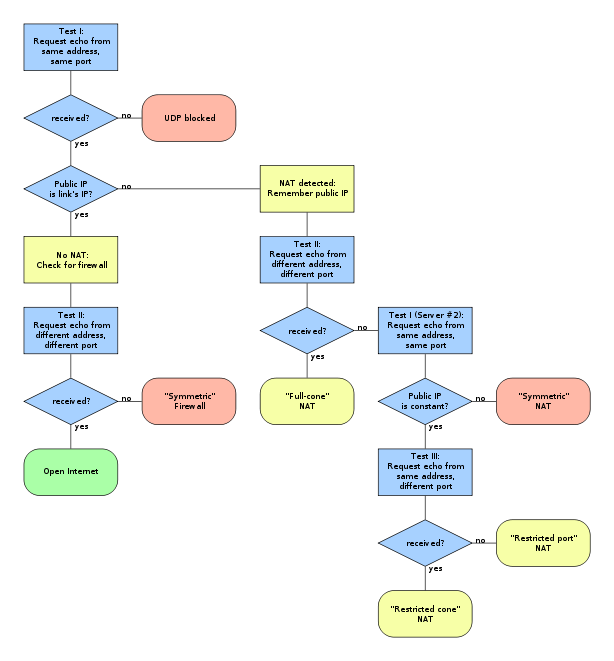STUN is a standardized set of methods, including a network protocol, used in NAT traversal for applications of real-time voice, video, messaging, and other interactive IP communications. STUN is an acronym for Session Traversal Utilities for NAT, and is documented in RFC 5389.[1] RFC 5389 obsoletes the previous specification, entitled Simple Traversal of User Datagram Protocol (UDP) through Network Address Translators (NATs), documented in RFC 3489.[2]
The obsolete version of STUN, sometimes referred to as Classic STUN,
was intended as a complete solution for NAT traversal, and featured an
algorithm to allow endpoints to determine NAT behaviour. The current
version of STUN is presented as a tool to be used by other protocols,
such as ICE. STUN removes the NAT classification algorithm and defines an extensible packet format.
The STUN protocol allows applications operating behind a network address translator (NAT) to discover the presence of the network address translator and to obtain the mapped (public) IP address (NAT address) and port number that the NAT has allocated for the application's User Datagram Protocol (UDP) connections to remote hosts. The protocol requires assistance from a third-party network server (STUN server) located on the opposing (public) side of the NAT, usually the public Internet. The original version of the protocol also specified methods to ascertain the specific type of NAT, but those methods have been deprecated in the newer specification, because of the plethora of specific NAT implementation behavior in various networking equipment and the resulting intractability of the problem and the deficiencies of the method used.
The algorithm consists of a series of tests to be performed by an application. When the path through the diagram ends in a red box, UDP communication is not possible and when the path ends in a yellow or green box, communication is possible.

The STUN protocol allows applications operating behind a network address translator (NAT) to discover the presence of the network address translator and to obtain the mapped (public) IP address (NAT address) and port number that the NAT has allocated for the application's User Datagram Protocol (UDP) connections to remote hosts. The protocol requires assistance from a third-party network server (STUN server) located on the opposing (public) side of the NAT, usually the public Internet. The original version of the protocol also specified methods to ascertain the specific type of NAT, but those methods have been deprecated in the newer specification, because of the plethora of specific NAT implementation behavior in various networking equipment and the resulting intractability of the problem and the deficiencies of the method used.
Classic STUN NAT characterization algorithm
Classic STUN specified an algorithm to characterize NAT behavior according to the address and port mapping behavior. This algorithm is not reliably successful and only applicable to a subset of NAT devices deployed.The algorithm consists of a series of tests to be performed by an application. When the path through the diagram ends in a red box, UDP communication is not possible and when the path ends in a yellow or green box, communication is possible.








0 comments:
Post a Comment
Note: only a member of this blog may post a comment.